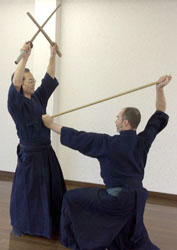
Shintō
Musō-ryū jō is said to be the oldest style
in Japan for using a stick (jō) in combat.
It was founded
in the early 17th century by Musō Gonnosuke,
an exponent of both Tenshin Shōden Katori Shintō-ryū and Kashima Shinden Jikishinkage-ryū. Tradition has it that Gonnosuke, in addition to mastering the secrets of Shintō-ryū, mastered the secret method of the Kashima lineage called "Ichi no Tachi".
Shintō
Musō-ryū lore maintains that Gonnosuke once fought
Miyamoto Musashi, one of the most famous swordsmen of the
time, with a more than 4ft-long wooden sword (yonshaku bokutō *) in a training match and was defeated
by Musashi's cross-block (jūjidome) technique.
According
to legend, Gonnosuke was dissatisfied with this outcome
and retired to Mt. Hōman, in what is now Fukuoka Prefecture,
in Kyūshū, where he engaged in a series of shugendō austerities,
all the while contemplating the reasons for his defeat. Finally, he received "divine" inspiration in the form of a dream about
a new method of using a staff-like weapon, making it shorter
(128cm) and thinner (25mm) for more rapid manipulation. He devised a number of techniques for this new innovative weapon, which
he called a stick (jō) (as opposed to staff or bō).
Factual documents of
the ryūgi are quite rare. It is said that there is
a document at Tsukuba Shrine, in Ibaraki Prefecture, that
reports that Gonnosuke was able to defeat Musashi in a rematch. Also at Tsukuba Shrine, it is said there is a treasury record of a 4-shaku 9-bu ōdachi (124cm large sword) donated by Musō Gonnosuke.
* An early English translation of Kaijō Monogatari suggested Gonnosuke used a staff and this became popularly cited in the West. However, the Kaijō Monogatari describes Gonnosuke fighting Musashi with a 四尺余り木刀 which concurs with Nitenki's account of a bokutō being used in the match, despite there being a discrepancy on its location.
Traditional
Curriculum
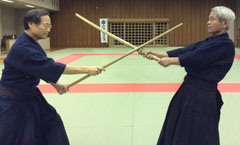 Training
is conducted in two person pre-arranged forms (kata). In Shintō Musō-ryū jō there are a total of 64 kata which are divided into a number of
sets (omote, chudan, ran-ai, kage, samidare, gohon-no-midare and okuden), each with a different character and purpose.
Training
is conducted in two person pre-arranged forms (kata). In Shintō Musō-ryū jō there are a total of 64 kata which are divided into a number of
sets (omote, chudan, ran-ai, kage, samidare, gohon-no-midare and okuden), each with a different character and purpose.
Practitioners begin their study of jō by learning a set of twelve basic stick and sword techniques (kihon waza), which contain all the essential movements of the style. They then proceed through the different sets of kata of stick versus sword(s) that were systematically and originally aimed to enable the exponent to successfully use the weapon in mortal combat.
Although frequently misunderstood, this type of traditional partnered kata training is conducive to ingraining highly-developed patterns of principle into the trainee's body through an ongoing process of practice and refinement. It is often said within Koryū Bugei (classical schools of martial arts) that when all of the curriculum's body of kata become just one, exponents are able to exit the forms and attain the ultimate state of unboundedness.
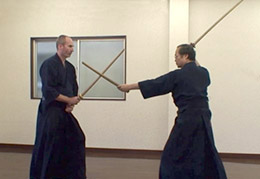 Also
included in the curriculum of Shintō Musō-ryū are
twelve kata of the swordsmanship system called Shintō-ryū
Kenjutsu (pictured right). The first eight kata are long sword vs long
sword(s), followed by four kata that are short sword vs
long sword.
Also
included in the curriculum of Shintō Musō-ryū are
twelve kata of the swordsmanship system called Shintō-ryū
Kenjutsu (pictured right). The first eight kata are long sword vs long
sword(s), followed by four kata that are short sword vs
long sword.
In
addition to Shintō Musō-ryū jō and Shintō-ryū kenjutsu, a number of associated
arts are taught during an exponent's training.
These are considered assimilated arts within Shintō Musō-ryū and include
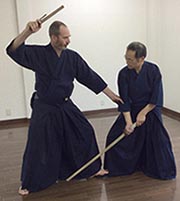
-
Uchida-ryū Tanjō (walking stick)
- Ikkaku-ryū Jutte (truncheon - pictured left)
- Isshin-ryū Kusarigama (ball, chain and sickle)
Dōjō Background
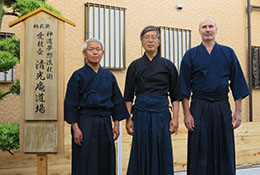 In terms of Shintō Musō-ryū styles, we follow the lineage from Shimizu Takaji Shihan.
In terms of Shintō Musō-ryū styles, we follow the lineage from Shimizu Takaji Shihan.
In Australia, our Dōjō has been uniquely exposed to the in-depth teachings of both Hamaji-ha and Nishioka-ha, and those useful and pertinent variations in both waza (techniques) and associated riai (underlying rationale) between Shimizu Shihan's first and last menkyo respectively.
Our Dōjōchō's (Greg Clarke) involvement within the transmission and teachings for 25+ years, including all the Fuzoku Ryūha (assimilated arts), has been, predominantly, an exclusive result of the extensive one-on-one training with and uninterrupted personal instruction from Japanese Shihan (master teachers) during regular and ongoing travel to Japan.
Likewise, all densho documentation or catalogues (licenses) have been issued and received in person directly within Japan.
Training
Training should not be taken lightly, it's demanding and intense, and given the size of the entire curriculum it does require a dedicated commitment. It's suitable for a person without disability, regardless of gender or previous martial arts experience and there's a minimum age requirement of 18.
As of 2024, Greg has elected to discontinue the Japanese Stick and Sword Arts (including ancillary arts) group classes that had been open to the public; primarily to enable shugyō into deeper keiko rather than a focus on teaching. However, he continues to teach privately in a limited group manner to select existing students, and through special guest or visitor invitation only.
Contact form: Click Here
